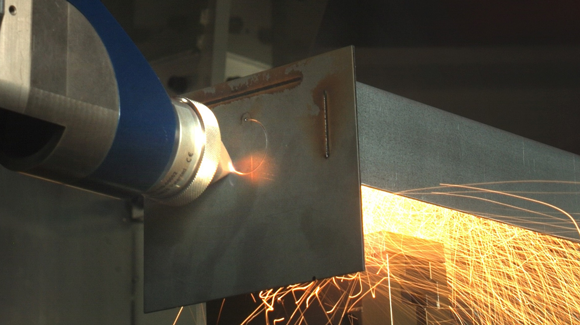Fraunhofer ILT project developing multi-functional laser tool for additive & subtractive manufacturing
June 10, 2019

Multi-functional laser processing head that can already cut and weld innovative sheet metal assemblies (Courtesy Fraunhofer ILT)
The Fraunhofer Institute for Laser Technology (ILT), headquartered in Aachen, Germany, has reported that it is coordinating an NRW Leitmarkt Project which is called MultiPROmobil, and will focus on developing a multi-functional laser tool that is capable of cutting, welding and Additive Manufacturing with one laser in one system. Project partners include Bergmann & Steffen GmbH, CAE Innovative Engineering GmbH and the Laser Processing and Consulting Centre (LBBZ GmbH), which join Fraunhofer ILT in developing a multi-functional laser processing head and robot technology for the flexible and economical production of sheet metal component assemblies.
According to the company, hybrid lightweight construction and electromobility require a balancing act between flexibility and productivity. “In volatile markets, laser technology combined with digitalisation is a predestined enabler for cost-effective production,” stated Dr Dirk Petring, Group Leader for Macro Joining and Cutting at Fraunhofer ILT and coordinator of the joint project, titled ‘Multifunctional robot technology with a universal laser tool for separating, joining and Additive Manufacturing processes in semi-bionic lightweight emobility’ – MultiPROmobil.
Fraunhofer ILT states that a combi-head from Laserfact GmbH is used which has been continuously developed over the last few years. In the future, this head will not only enable users to integrate cutting and welding but also to additively manufacture structures, which the company reports is already possible using a replaceable nozzle module. The project partners are currently said to be working on optimising the combi-head so that it can execute all three processes in a production plant without changing the optics or nozzles. The project is also focused on developing intelligent design and simulation software. With ‘Digital Twins’, the project partner CAE Innovative Engineering can image machines, processes and components prior to production, so that key aspects of the process chain can be identified and improved.
It is believed that by using the flexible process chain, the MultiPROmobil partners can digitally display new vehicle components, then test and evaluate the developed technology. In an industrial environment at project partner LBBZ, a robot that masters all three manufacturing disciplines will produce semi-bionic vehicle structures using the laser tool.
As the first application example, the triangular control arm of an electric vehicle will be designed and cut, then welded and reinforced with additive structures in the multi-functional laser robot cell, all without a single tool change. Of particular importance here is the flexibility of the clamping technology developed by Bergman & Steffen GmbH. In the future, several multi-functional robots are to be used in highly-flexible manufacturing cells, depending on the size of the assembly and the required cycle time.
The project partners predict that engineering efficiency can be increased and start-up times reduced by around 30% each, and also aim to reduce unit costs and resource consumption by at least 20% each. “With agile, laser-based manufacturing, process chains for the production of sheet metal assemblies can be made very flexible and scalable so that they can be gradually introduced into electromobility applications, ” added Dr Petring.
The project, which started on November 15, 2018, is expected to appeal to small- and medium-sized companies and the MultiPROmobil project is expected to run for three years, and is funded by the European Regional Development Fund (ERDF) and the State of North Rhine-Westphalia.
















